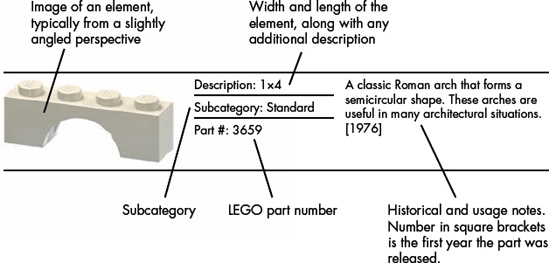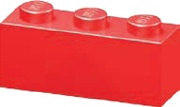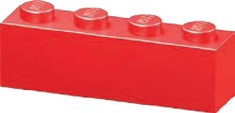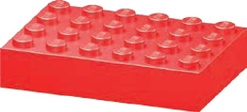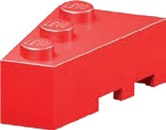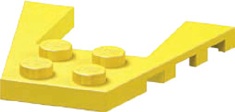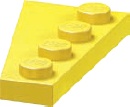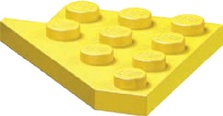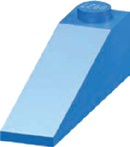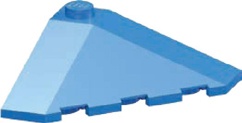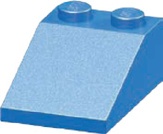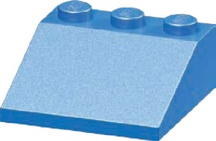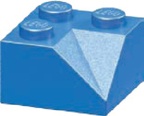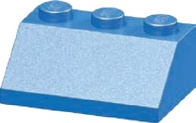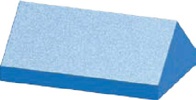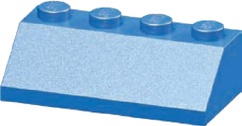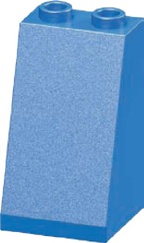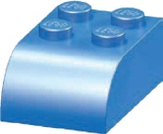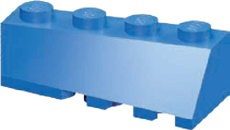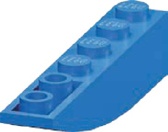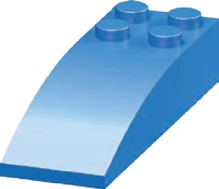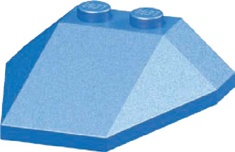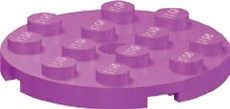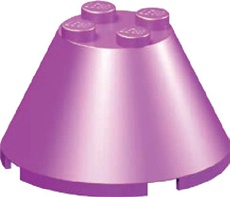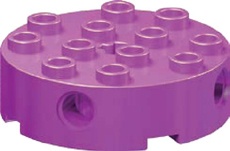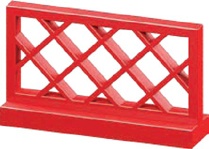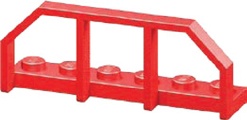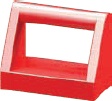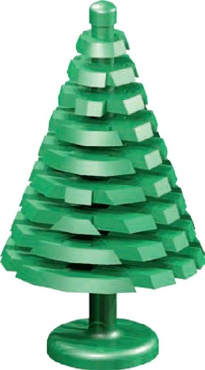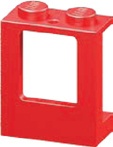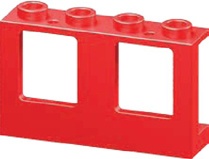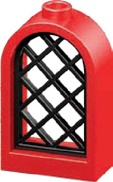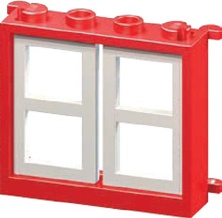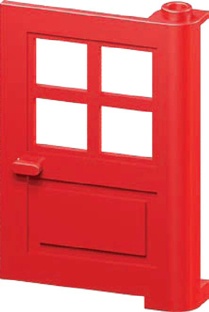The LEGO system is made up of thousands of elements. Some are different sizes of the same type of piece (like 2×3 and 2×4 bricks), while others are exactly the same size with different decorations or patterns printed on them.
I’d need an entire book in order to catalog every piece in the system. Instead, this Brickopedia contains a selection of more than 275 elements, from basic bricks, slopes, and plates, to specialized elements, arches, and even decorative elements. The pieces included represent the most common and most reusable elements in the LEGO system, and they are the most likely to be found in your own LEGO collection. In the case of bricks, plates, slopes, and arches, I’ve included nearly every basic element that falls into those categories. In some of the other categories (such as specialized elements and decorative pieces), I’ve included a narrower selection of pieces, focusing on those that offer the most creative possibilities and interaction with other basic parts.
As you’ll see, I’ve categorized the Brickopedia from the perspective of building with LEGO pieces. As a result, I suggest that you do not use it to plan purchases of LEGO pieces because its categories and terminology may not match the ones used by stores or websites. Some of the categories and descriptions are unique to this text. I hope that you’ll find the Brickopedia useful in your attempts to categorize, organize, and, of course, build with the LEGO system of parts.
The Brickopedia contains a separate entry for each element. Each entry contains several pieces of information, as shown in Figure A-1.
This information notes why you might have certain pieces in your collection, suggests how to use them, or in some cases, just offers an interesting anecdote about the part.
The category and subcategory names convey the nature of the pieces. Whenever possible, I’ve cataloged similar parts together, like standard and inverted slopes of the same size, to show their relationship. I’ve also divided the LEGO elements into several broad categories. Each category contains subcategories that further refine the way pieces are classified (see Table A-1). Table A-2 through Table A-10 catalog each major category from basic bricks to decorative elements.
Table A-1. LEGO Element Categories and Subcategories
Subcategory | Description | |
|---|---|---|
Bricks | Standard | Rectangular sides, same height as a 1×1 brick. |
Adapted | Irregular sides/shape or taller than a standard 1×1. | |
Plates | Standard | Square or rectangular shape, same height as a 1×1 plate. |
Adapted | Irregular sides/shape. “Quarter cut” or “diamond cut” describes pieces that can be combined to form a circle or a diamond shape. | |
Bows | One edge has symmetrical angles cut away, whereas the opposite edge is straight or indented in the center. | |
Wings | Available in left and right varieties, shaped like airplane wings. | |
Slopes | Standard | The angled face is usually on the top part of the element. |
Inverted | The angled face is usually on the underside of the element. | |
Corners | Any slope that can be used to form a corner where two rows of the same type of slope meet at 90 degrees. | |
Peaks | Two or more angled faces meet at the top of the element. When in place, there are no exposed studs. | |
Compound | Two or more (flat or curved) angled faces. | |
Curved | Angled faces that have a curve. | |
Specialized Elements | Junctions | Elements with studs on their sides or with a portion perpendicular to another part. These pieces allow you to join two or more pieces to make a bend in or change the shape of a model. |
Odd Faces | Elements with one or more irregularly shaped, contoured, or textured faces. | |
Hinges and Turntables | Hinges are bricks or plates that meet at a flexible joint. Turntables allow attached elements to rotate. Both hinges and turntables can add movement to a model. | |
Pin-Enabled | Bricks or plates with a Technic-style pin attached on the sides, top, or bottom, or elements capable of accepting a pin. | |
Wheels/Tires | Pieces that add motion to vehicles. | |
Arches | Standard | A single piece that creates a complete arch. |
Half | A piece that forms only half of the complete arch. Studs are on top as with the standard variety. | |
Half Inverted | A piece that forms only half of the complete arch. Tubes are on the bottom, and no studs are showing. The arch is on top of the element. | |
Tiles and Panels | Standard | Standard tiles are any flat elements that are the same height as a plate but have no exposed studs. Standard panels are thin elements that can create a division smaller than a full-width brick. |
Inverted | Inverted tiles have smooth undersides with no exposed tubes, but they do have studs on top, unlike standard tiles. | |
Cylinders and Cones | Standard | Standard cylinders are cylindrical elements that resemble a coffee can or a drum. Standard cones are elements shaped like upside-down ice cream cones. |
Adapted | An element that is only partially cylindrical or conical. Pairs or groups of this kind of element can be combined to form a complete cylinder or cone. | |
Baseplates | Standard | Baseplates that are one full brick in height and 8×16 studs or larger. |
Waffle | Any thin baseplate with a waffled underside that does not accept studs. | |
Decorative Elements | Fences, Rails, and Rungs | Latticework or ladder-like elements that can be used as fences, grilles, hand rails, and so on. |
Bars, Clips, and Handles | Bars are the diameter of a minifig hand; clips are bricks or plates that can hold them in place. Handle elements have a bar-sized portion attached to an otherwise standard piece. | |
Foliage | Any element that looks like flowers, trees, shrubs, or other greenery. | |
Ornamental | Any piece that is purely decorative but isn’t some type of foliage. A flag is perhaps the best example of this type of element. | |
Doors/ Windows | Pieces that can be used as doors or windows. |
Table A-2. The Bricks Category
Table A-3. The Plates Category
Table A-4. The Slopes Category
Table A-5. The Specialized Elements Category
Specifications | Notes | |
|---|---|---|
 | Description: 2×2 macaroni | This is one of the most beloved pieces ever produced, but it’s often difficult or expensive to acquire in large quantities. [1958] |
Subcategory: Odd Faces | ||
Part #: 3063 | ||
 | Description: 4×4 macaroni | An excellent companion to the original 2×2 macaroni brick. [2004] |
Subcategory: Odd Faces | ||
Part #: 48092 | ||

| Description: 1×1 with indented stud on one side | The famed headlight brick shown from both front and back. You can attach it to other pieces in various ways. The indented stud on the side can hold transparent 1×1 cylinder plates to create faux headlights, or you could use a row of these to attach a 1×N element horizontally. The opening in the back can accept a single stud of any kind. [1979] |
Subcategory: Junctions | ||
Part #: 4070 | ||
 | Description: 1×1 with stud on one side | This piece, long awaited by many builders, takes the usefulness of the headlight brick to another level by moving the side stud flush with the face of the brick. Having these studs on only one side allows this piece to become part of any wall. [2009] |
Subcategory: Junctions | ||
Part #: 87087 | ||
 | Description: 1×1 with studs on two sides | Introduced five years before #87087, this piece offers studs on opposite sides to which you can attach other pieces. [2004] |
Subcategory: Junctions | ||
Part #: 47905 | ||
 | Description: 1×1 with studs on all sides | This element is sometimes called the hydrant brick. Although its design is amazing, it has one drawback: Often the studs you aren’t using just get in the way. [1985] |
Subcategory: Junctions | ||
Part #: 4733 | ||
 | Description: 1×2 with two studs on both sides | This 1×2 brick has six exposed studs upon which to attach other elements. [2005] |
Subcategory: Junctions | ||
Part #: 52107 | ||
 | Description: 1×4 with studs on one side | Although maybe not the most elegant part, this piece is one of the most functional. It’s small enough to build into almost any structure, while offering four horizontal studs onto which you can securely attach other pieces. [2000] |
Subcategory: Junctions | ||
Part #: 30414 | ||
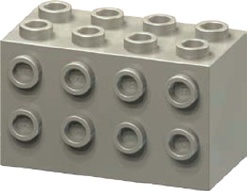 | Description: 2×4×2 with studs on two sides | This solid piece can form the core of junction substructures. [1990] |
Subcategory: Junctions | ||
Part #: 2434 | ||
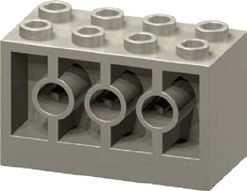 | Description: 2×4×2 with tubes on two sides | The industrial look of this 2×4×2 with tubes on two sides earns it the nickname “engine block.” [1992] |
Subcategory: Junctions | ||
Part #: 6061 | ||
 | Description: 1×2 single-stud offset plate | This short element allows you to recess parts of a model one-half stud deep, allowing you to add greater subtlety to the shape and feel of your work. [1977] |
Subcategory: Junctions | ||
Part #: 3794 | ||
 | Description: 2×2 single-stud offset plate | A really useful piece when building with the offset technique. [2009] |
Subcategory: Junctions | ||
Part #: 87580 | ||
 | Description: 1×4 plate with two studs | Is this a plate missing two studs or a tile with two extra studs? The studs are in the standard place, but the smooth portion in the middle is unique. [2011] |
Subcategory: Junctions | ||
Part #: 92593 | ||
 | Description: 1×1 to 1×1 bracket | When you need to change directions in a very small space, use this. The hole on top is exactly one stud in diameter, and the area around it is exactly the height of a stud. [2002] |
Subcategory: Junctions | ||
Part #: 554 | ||
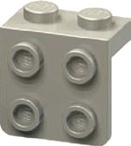 | Description: 1×2 to 2×2 bracket | You can easily insert these pieces into a vertical wall, leaving the four-studded side exposed and available for attaching other parts. [2002] |
Subcategory: Junctions | ||
Part #: 44728 | ||
 | Description: 2×2 to 2×2 bracket | One of the earliest parts to offer studs perpendicular to its base. This gem showed up in some of the classic Space-themed sets of the late 1970s. [1978] |
Subcategory: Junctions | ||
Part #: 3956 | ||
 | Description: 1×2 to 1×4 bracket | Similar to #44728, except that the four horizontal studs are in one row rather than in two rows of two. You’ll find this useful for attaching an element directly to a vertical wall. [1987] |
Subcategory: Junctions | ||
Part #: 2436 | ||
 | Description: 1×2 log | Odd Face is the name given to this subcategory because the “face” or front surface of these bricks is something other than standard studs or a smooth wall. The log brick is, of course, useful in brown, but grey versions are interesting too. [1996] |
Subcategory: Odd Faces | ||
Part #: 30136 | ||
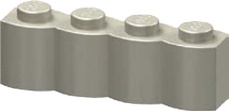 | Description: 1×4 log | This is the longer version of #30136. As this book goes to press, there isn’t a 1×1 log brick, but you can sometimes substitute a 1×1 cylinder to get a similar effect. [1996] |
Subcategory: Odd Faces | ||
Part #: 30137 | ||
 | Description: 1×2 grille | A unique piece in that the oddness of its face is different from front to back. Use these in groups or rows with similar faces exposed, or mix the faces for a great effect. Because both sides are grille-like, you’ll sometimes see these used as grates on the sides of machinery, as roll-up doors on fire trucks, or even as corrugated steel panels. [1986] |
Subcategory: Odd Faces | ||
Part #: 2877 | ||
 | This is a slope, but not in the traditional sense. It’s useful for creating realistic-looking vents and grates on machines and vehicles. [2008] | |
Subcategory: Odd Faces | ||
Part #: 61409 | ||
 | Description: 1×2 and 1×2 plate | Although technically two pieces, this pair is almost always used together (like for the arms on miniland figures in Chapter 4). [1987/1987] |
Subcategory: Hinges | ||
Part #: 2429/2430 | ||
 | Description: 1×2 and 1×2 brick | Use this pair of parts to create a wall section that swings away from the rest of a building or to create fixed angled sections. [1977/1977] |
Subcategory: Hinges | ||
Part #: 3830/3831 | ||
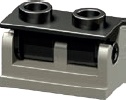 | Description: 1×2 brick | Use these pieces to allow a spaceship cockpit to move, or angle the studs forward and build it into a stationary wall. Once the studs are exposed, you can use them to attach other elements. [1978/1978] |
Subcategory: Hinges | ||
Part #: 3937/3938 | ||
 | Description: 2×2 brick | The bottom portion of this element is the same as the 1×2 hinge brick above. The larger top portion allows you to attach even larger roofs, hoods, or doors that swing. [1978/1991] |
Subcategory: Hinges | ||
Part #: 3937/6134 | ||
 | Description: 2×5 plate | This classic piece is sometimes used to attach things like fire truck ladders, but it could just as well be used as the hinge for wings on a bird. [1967] |
Subcategory: Hinges | ||
Part #: 3149 | ||
 | Description: 2×2 plate | This piece is a scaled-down version of the larger 4×4 turntable (shown below) but is only one plate high and can hide in many inconspicuous areas of a model. [1977] |
Part #: 3680 | ||
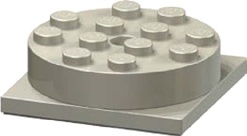 | Description: 4×4 brick | This turntable is the “modern” version of a similar element produced in 1963. Earlier versions lacked the square baseplate seen here; they were cylindrical all the way to the bottom. [1977] |
Subcategory: Turntables | ||
Part #: 3403 | ||
 | Use this piece to build a substructure that can slide into the 1×4 channel face element (#2653). It’s also available in a 1×8 version. [1997] | |
Subcategory: Odd Faces | ||
Part #: 32028 | ||
 | Description: 1×2 channel face | This part is sometimes seen as a stacked decorative element. [1981] |
Subcategory: Odd Faces | ||
Part #: 4216 | ||
 | Description: 1×4 channel face | This piece can be both decorative and useful for accepting substructures mounted on the #32028 channel rail plates. [1991] |
Subcategory: Odd Faces | ||
Part #: 2653 | ||
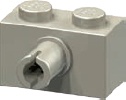 | Description: 1×2 pin face with one pin | Say you’ve built a substructure on rail plates and are using the 1×4 channel brick to mount it. Use this brick to lock it in place with 1×2 Technic bricks. [1988] |
Subcategory: Pin-Enabled | ||
Part #: 2458 | ||
 | Description: 1×2 pin face with two pins | The pin configuration on this piece matches any two holes on any other Technic brick. Note that its pins are centered under the studs, unlike #2548 above. [2000] |
Subcategory: Pin-Enabled | ||
Part #: 30526 | ||
 | Description: 2×2 pin face | Try this piece when you need a pin as a secure part of a solid wall. Build it into a 2×N wall to add a sturdy pin onto which you can attach almost anything. [1985] |
Subcategory: Pin-Enabled | ||
Part #: 4730 | ||
 | Description: 2×2 pin top | You may not need this piece often, but when you do, you’ll be glad it exists. The same goes for the plate version of this part (#2460). [1995] |
Subcategory: Pin-Enabled | ||
Part #: 4729 | ||
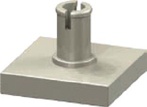 | Use this part to mount the rotors for a small helicopter and so much more. You can turn this element on its side and connect its pin to a Technic brick that’s been built into the side of a model. You can then attach other pieces to the bottom of this plate. [1988] | |
Subcategory: Pin-Enabled | ||
Part #: 2460 | ||
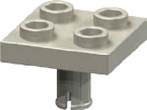 | Description: 2×2 pin-drop plate | Like the #2460, the #2476 plate also offers some interesting possibilities. For example, two of these plates will fit perfectly side by side when their pins are inserted into a 1×4 Technic beam. [1988] |
Subcategory: Pin-Enabled | ||
Part #: 2476 | ||
 | Description: 2×2 single-drop-hole plate | These pieces allow Technic pins or axles to attach below bricks or plates. The #2444 element has only one hole on one side. The #2817 has two holes. [1987/1989] |
Subcategory: Pin-Enabled | ||
Part #: 2444 | ||
 | Description: 2×2 double-drop-hole plate | |
Subcategory: Pin-Enabled | ||
Part #: 2817 | ||
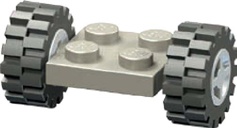 | Even compact models may require motion. This wheel/tire set is mounted on a tiny 2×2 plate with slender pins sticking out of each side. [1985/1986/1985] | |
Subcategory: Wheels/Tires | ||
Part #: 4600/4624/3641 | ||
 | Description: 2×2 wide plate with slick tires | If you’re creating a microscale street machine, why not include some mean-looking slicks? The plate in this figure sets the wheels out wider than the parts above, which can give your street rod more of a racing look. [1994/1991/1996] |
Subcategory: Wheels/Tires | ||
Part #: 6157/6014/30028 | ||
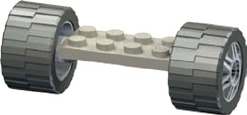 | Description: 2×4 wide plate with wheels/tires | If you need wider wheels for a wider vehicle than the 2×2 options above allow, use this piece, which can exchange tires with its brick-sized counterpart (next). [1998/2006/2001] |
Subcategory: Wheels/Tires | ||
Part #: 30157/55981/30648 | ||
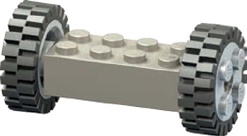 | The wheels here (with the four studs showing) are sometimes referred to as Freestyle, after the sets they came from. They spin freely on pins jutting out from the sides of the 2×4 brick. [1995/1988/1985] | |
Subcategory: Wheels/Tires | ||
Part #: 6249/6248/3483 | ||
 | Description: Medium wheels with Technic axle holes | These wheels with Technic axle holes can be used in many ways. Pop some Technic bricks on this axle, and you can mount these wheels on any size car. [1984/1985] |
Subcategory: Wheels/Tires | ||
Part #: 3482/3483 | ||
 | Description: Brick separator | Although they’ve been replaced with a streamlined version, there are still lots of the original brick separators around. [1990] |
Subcategory: n/a | ||
Part #: 6007 | ||
 | Description: Brick separator | The reengineered brick separator is slimmer than the original. Its thin front edge allows you to remove tiles and offset plates. The feature on top allows you to remove axles from Technic bricks or parts like the 2×2 cylinder (#3941). [2011] |
Subcategory: n/a | ||
Part #: 630 |
Table A-6. The Arches Category
Part | Specifications | Notes |
|---|---|---|
 | Description: | This piece is perfectly suited for building arched windows into thick castle walls. It’s probably the smallest possible arch piece that can be both practical and elegant. [1976] |
Subcategory: Standard | ||
Part #: 4490 | ||
 | Description: 1×4 | A classic Roman arch that forms a semicircular shape. These arches are useful in many architectural situations. [1976] |
Subcategory: Standard | ||
Part #: 3659 | ||
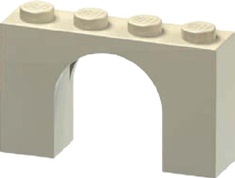 | Description: 1×4×2 | Given its shape, it’s no surprise that this element shows up in a number of medieval-themed sets. [1994] |
Subcategory: Standard | ||
Part #: 6182 | ||
 | Description: 1×6 | The radius of this arch is much greater than that of the 1×6×2 shown next (#3307). [1972] |
Subcategory: Standard | ||
Part #: 3455 | ||
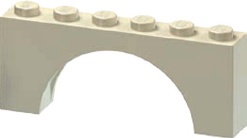 | Description: 1×6×2 | Like the 1×4 arch (#3659), this piece represents a classic Roman shape. A series of these can create a pleasing arcade for any building. [1971] |
Subcategory: Standard | ||
Part #: 3307 | ||
 | Description: 1×8×2 | Like the 1×6 arch, this piece has a slightly greater radius for the arch shape. [1971] |
Subcategory: Standard | ||
Part #: 3308 | ||
 | Description: 2×8×3 | This part has appeared in a number of assorted buckets, mostly aimed at younger builders. [1985] |
Subcategory: Standard | ||
Part #: 4742 | ||
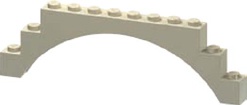 | Description: 1×12×3 | Now that’s an arch! Impressive in size, this piece adds a grand opening to train tunnels, fire stations, and other structures. [1993] |
Subcategory: Standard | ||
Part #: 6108 | ||
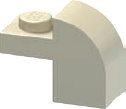 | Description: 1×2 | Tuck this compact piece under #6005 (below) to create interesting shapes in matching or complementary colors. [1992] |
Subcategory: Half | ||
Part #: 6091 | ||
 | Description: 1×3×2 | Part #6091 fits nicely under this arch. By itself, this piece can also be a flying buttress-type arch. [1995] |
Subcategory: Half | ||
Part #: 6005 | ||
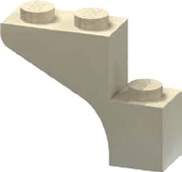 | Description: 1×3×2 | This graceful little inverted arch is like the faux inverted arches (made from inverted 1×2 slopes) we saw in the train station model in Chapter 3. [2010] |
Subcategory: Half Inverted | ||
Part #: 88292 | ||
 | Description: 1×5×4 | Used alone, this flying buttress arch starts at a point away from a wall or structure and meets with the top of its half arch. When used in pairs, these pieces become a 1×10×4 arch. [1986] |
Subcategory: Half | ||
Part #: 2339 | ||
 | Description: 1×5×4 | This half arch is another case where more than a decade separates the release of a standard part (like #2339) and the release of its inverted counterpart. [1997] |
Subcategory: Half Inverted | ||
Part #: 30099 | ||
 | Description: 1×6×2 | No, it’s not the handle from a LEGO lunchbox, though it could be. It’s an arch with gently curved corners that can be used as a wonderful decorative piece. [1994] |
Subcategory: Standard | ||
Part #: 6183 | ||
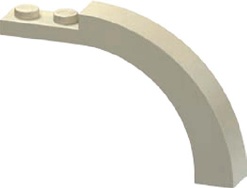 | Probably the piece best suited to being a flying buttress, it really extends outward from the top until it reaches the bottom of the half arch. Simply elegant. [1992] | |
Subcategory: Half | ||
Part #: 6060 |
Table A-7. The Tiles and Panels Category
Part | Specifications | Notes |
|---|---|---|
 | Description: 1×1 tile | Although a similar part was released in 1971, this modern version includes a tiny groove around the base, which makes it easier to remove. [1978] |
Subcategory: Standard | ||
Part #: 3070B | ||
 | Description: 1×2 tile | Like the 1×1, this is the second version of this part. The first, without the groove around the bottom, was first seen in 1968. [1977] |
Subcategory: Standard | ||
Part #: 3069A | ||
 | Description: 1×3 tile | 2010 saw the introduction of two new tiles to the LEGO system. This 1×3 version was joined by a 2×4 version shown below (#87079). [2010] |
Subcategory: Standard | ||
Part #: 63864 | ||
 | Description: 1×4 tile | Run these in series down the middle of a few rows of black tiles to create the lines of a divided road. [1987] |
Subcategory: Standard | ||
Part #: 2431 | ||
 | Description: 1×6 tile | A tile like this could become the top edge of the sides of a microscale ship, like the one in Chapter 6. [1995] |
Subcategory: Standard | ||
Part #: 6636 | ||
 | Description: 1×8 tile | To make small helicopters look more real, try using these pieces as rotors. [1980] |
Subcategory: Standard | ||
Part #: 4162 | ||
 | Description: 2×2 tile | Sidewalks are just one of many uses for standard 2×2 tiles. Mix them with 1×N tiles of different colors to create streets or parking lots. [1976] |
Subcategory: Standard | ||
Part #: 3068B | ||
 | Description: 2×4 tile | When you need to smooth out a lot of surface area, use these elements that cover eight studs apiece. [2010] |
Subcategory: Standard | ||
Part #: 87079 | ||
 | Description: 2×2 cylinder | It’s a manhole cover and more! Like many other tiles, this part also has a small groove at its bottom edge, which makes it easier to remove. [1983] |
Subcategory: Standard | ||
Part #: 4150 | ||
 | Description: 2×2 cylinder | This isn’t exactly a true inverted plate—it has a curved underside. It’s sometimes called a boat plate, since you can attach these pieces under boats to allow them to skim over carpet or other surfaces. [1991] |
Subcategory: Inverted | ||
Part #: 2654 | ||
 | Description: 1×1×1 panel | This piece is great for creating hollowed-out areas along the face of a solid wall. It works well with #4865 shown next. [1995] |
Subcategory: Standard | ||
Part #: 6231 | ||
 | Description: 1×2×1 panel | This element could be a tiny little couch, the steps on the sides of vehicles, or tiny accents on a large open space. [1985] |
Subcategory: Standard | ||
Part #: 4865 | ||
 | Description: 1×4×1 panel | A longer version of #4865 above. [2000] |
Subcategory: Standard | ||
Part #: 30413 | ||
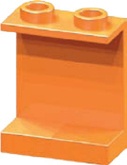 | Description: 1×2×2 panel | Try using these panels on an outside wall to leave room inside the model for moving parts or other substructures. [1997] |
Subcategory: Standard | ||
Part #: 4864 | ||
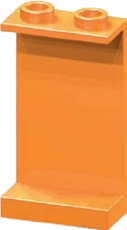 | Description: 1×2×3 panel | Panels are useful no matter which direction they’re facing. When turned like this piece, they can add an indent to an otherwise dull wall, but when turned 180 degrees, they look solid. [1998] |
Subcategory: Standard | ||
Part #: 2362 | ||
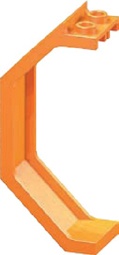 | Description: 3×2×6 panel | Not all panels are flat. Some, like this one, are made up of several thin, flat sides meeting at interesting angles. [1988] |
Subcategory: Standard | ||
Part #: 2466 | ||
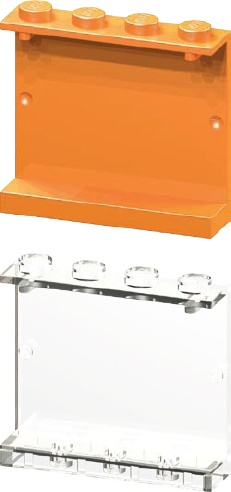 | Description: 1×4×3 panel | Many parts are available in transparent colors. This panel is available in several opaque colors, but the clear version (same part number) allows you to use it as a window for a large office building or a minifig structure where you need a lot of light. [1994] |
Subcategory: Standard | ||
Part #: 4215A |
Table A-8. The Cylinders and Cones Category
Table A-9. The Baseplates Category
Table A-10. The Decorative Elements Category
